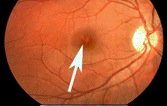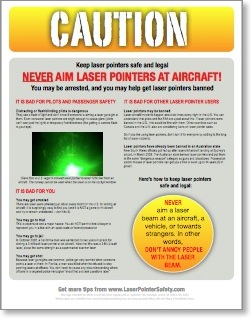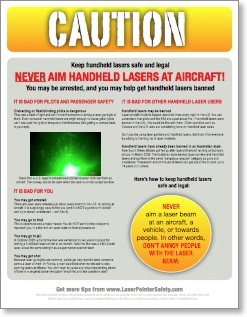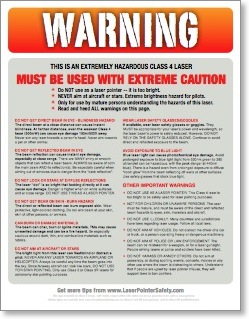Home
A comprehensive resource for safe and responsible laser use

Don’t aim laser pointers at a person’s head and eyes
Don’t aim a laser pointer towards a person’s head. This is to prevent the beam from getting in their eyes, possibly causing eye damage. Remember that people can move unexpectedly, so keeping away from their heads is a good idea.
Keep away from strangers
Also, don’t shine a laser on or near a stranger. This is annoying, to say the least. It can be upsetting -- seeing the dot may create fear that a person is being targeted by a laser gunsight. This misuse creates a bad image for laser pointers.
In sports, there have been cases of “laser louts” who aim lasers at sport players in a stupid attempt to disrupt the play. It goes without saying this is unacceptable and is illegal. It is this kind of behavior that causes the public to support a ban on laser pointers.

Why lasers can cause eye damage
A laser’s light is concentrated into a narrow beam. If aimed at a person’s eye from close up, most or all of the light goes through the pupil. The already-concentrated light is further focused by the lens onto a sharp (“diffraction-limited”) dot on the retina.
The power density from a 1 milliwatt laser, focused to a point, is brighter than the equivalent area of the sun’s surface. This can cause a detectable change (injury) to the retina, if the laser stays in one spot for a few seconds. This is why in some countries such as the U.K., laser pointers are limited to 1 milliwatt or less.
Safety of visible lasers relies on a blink reflex and/or aversion response where bright light causes blinking and/or moving out of the light. Because the blink reflex has been considered to limit the exposure time, lasers with an output less than about 5 milliwatts are generally considered safe for the public to use. In the United States, laser pointers are allowed if they are 5 milliwatts or less. According to the U.S. Food and Drug Administration (FDA), as of April 2012 they have never received a report of eye injury from momentary exposures to laser pointers below 5 milliwatts.
Similarly, three top U.K. eye experts wrote in April 2016 that “…laser pointers, pens or key rings if used appropriately are not an eye hazard, and even if used inappropriately will not cause permanent eye damage. This statement has been supported by the finding that until recently no irreversible eye injuries had been reported for a period of almost 15 years other than those caused by deliberate and prolonged viewing of laser beams. During this time period pointers have been freely available with an estimated 500 000 to c1.2 million laser pointers in circulation.” (It should be noted this statement is valid only for lasers under 5 milliwatts. In the same article they said over 150 permanent eye injuries have occurred in the U.K. from misuse of higher powered consumer lasers.)
Deliberate staring at a beam under 5 milliwatts can cause blind spots; this has happened to drunk or stupid people. FDA has heard of injuries caused when a person intentionally stared into the beam for a prolonged period of time.

A UK youth deliberately aimed a laser pointer in his eyes. This is what happened to his left eye, as reported here.
As laser power further increases, the chance of eye injury increases. Even blinking may not help. Above roughly 10 to 20 milliwatts for visible continuous-wave lasers, even an accidental direct hit on an eye at close range (where all of the beam enters the pupil) could cause retinal damage. If the person was looking straight at the laser, the burn will be in the center of a person’s vision. In extreme cases of eye damage, central vision could be almost fully lost, and the person becomes blind in that eye.
The further a person is from the laser source, and the shorter the time that the laser light is on the eye, the less chance of eye injury. This is why a handheld laser that could pop balloons, ignite cigarettes or cause instant eye injuries at close range, probably would not be able to cause even minor eye injuries to a pilot flying an aircraft. The pilot’s eye is much further away (a laser beam does spread out with distance, so not all the light goes into a pilot’s pupil). Also, it is difficult to hand-hold a laser onto a moving target, so the exposure time may be brief (the pilot sees bright flashes rather than a steady light).
FDA issued a December 2010 safety notification stating “Lasers that emit more than 5mW output power can cause irreversible eye injury of increasing severity with increased output power.” FDA noted that “Although illegal and potentially dangerous, they are increasingly available on the Internet and in stores. The FDA wants to make consumers aware that they should not buy these lasers for themselves or as gifts for others.”
Invisible infrared hazards
In addition to visible light, some green laser pointers also emit invisible infrared (IR) light. This is most common in cheap, poorly-constructed lasers where an IR filter is not used due to saving a few cents. This can lead to a literally invisible hazard. For example, one laser tested by a U.S. government agency had a dim visible green light while outputting 20 mW of IR (four times the U.S. legal limit).
For more information on this eye hazard, and on how to test your own green lasers for IR light, see this news item.
Balloon-popping lasers are also burn hazards
Higher-power laser pointers can also be burn hazards. If a pointer can pop balloons, as some in the 250 milliwatt range can, then it could cause skin burns similar to hot wax, and of course it would be a serious eye hazard.
Don’t aim lasers at people
There are many danger factors. In general, the more powerful the laser, the closer a person is to the beam, and the longer the laser stays in the same area of the eye, the greater the possibility of eye damage. While eye injuries from lasers are rare, all laser beams should be treated as potentially dangerous. For this reason, always keep any laser beam away from a person’s head and eyes.
How to stay safe and keep laser pointers legal
NEVER aim a laser beam at an aircraft, a vehicle, or towards strangers. In other words, DON’T ANNOY PEOPLE WITH THE LASER BEAM.
Additional information
If you have a Class 2, II, 3R or IIIA laser pointer (power below 5 mW), click the blue link for a PDF sheet about safe use:
insert-for-laser-pointers

If you have a Class 3B or IIIB laser (power between 5 mW and 500 mW (1/2 watt)), click the blue link for a PDF sheet about safe use:
insert-for-3Bhandheld-lasers

If you have a Class 4 or IV laser (power above 500 mW (1/2 watt)), click the blue link for a PDF sheet about safe use:
insert-for-Class4handheld-lasers
